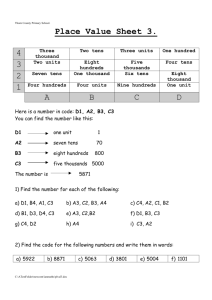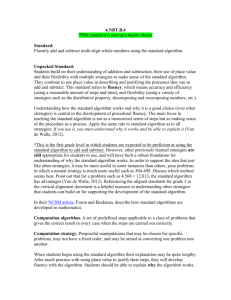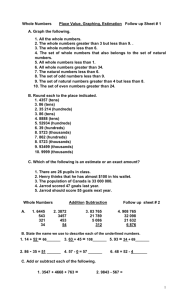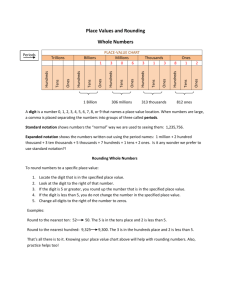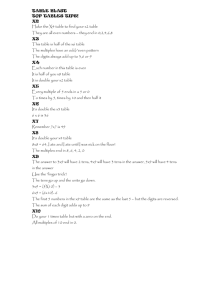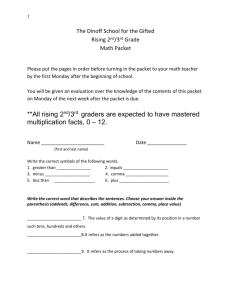Exchange (Ages 5 – 7) Understanding place value and regrouping
advertisement
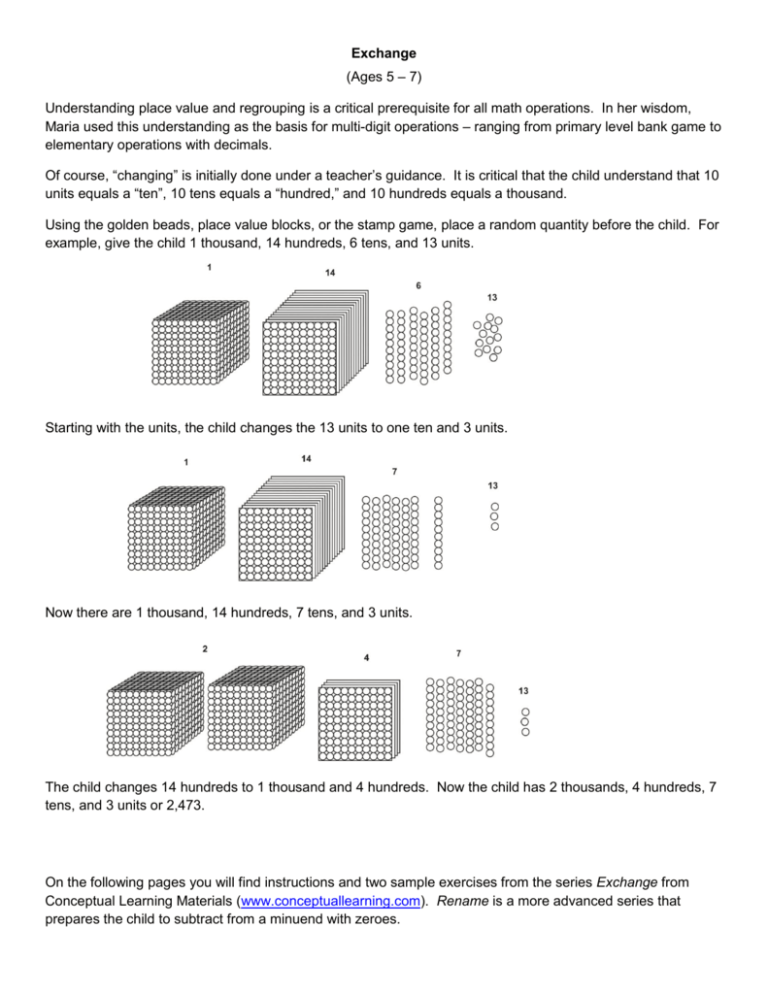
Exchange (Ages 5 – 7) Understanding place value and regrouping is a critical prerequisite for all math operations. In her wisdom, Maria used this understanding as the basis for multi-digit operations – ranging from primary level bank game to elementary operations with decimals. Of course, “changing” is initially done under a teacher’s guidance. It is critical that the child understand that 10 units equals a “ten”, 10 tens equals a “hundred,” and 10 hundreds equals a thousand. Using the golden beads, place value blocks, or the stamp game, place a random quantity before the child. For example, give the child 1 thousand, 14 hundreds, 6 tens, and 13 units. Starting with the units, the child changes the 13 units to one ten and 3 units. Now there are 1 thousand, 14 hundreds, 7 tens, and 3 units. The child changes 14 hundreds to 1 thousand and 4 hundreds. Now the child has 2 thousands, 4 hundreds, 7 tens, and 3 units or 2,473. On the following pages you will find instructions and two sample exercises from the series Exchange from Conceptual Learning Materials (www.conceptuallearning.com). Rename is a more advanced series that prepares the child to subtract from a minuend with zeroes. Exchange Matching Set 1. All pieces on each sheet are designated with the same number code in the lower right corner and should be cut and stored in the same drawer or envelope. Each sheet is comprised of ten pairs for two-part matches or eight sets of three for three-part matches. Each of the Exchange, Rename, and Equivalence sets consists of a series of ten different exercises. 2. The student may work either at table or on the floor. If working on the floor, it is recommended that he or she lay out the work on a small mat. Carpet samples or rectangular place mats work well. 3. Each exercise consists of eight or ten problem cards to be matched with one or two other pieces. The exercise below shows a sample problem set. As a guide in laying out the work, it is recommended that the child place all the cards labeled "1st" in a vertical column as illustrated below. 4. The child then matches the card designated "2nd" to the first card.. Young children will use the golden beads, place value blocks, or stamp game to figue out the simplified value. Older children may abstract some of the matches, but should still use manipulatives when needed. 5. Young children may do only two or thee matches in a session. Older children may be ready to all 10 matches at a sitting. 1st 2nd 92 8 tens, 12 ones Exchange 1 1st Exchange 1 2nd 94 8 tens, 14 ones Exchange 1 1st Exchange 1 2nd 99 8 tens, 19 ones Exchange 1 1st Exchange 1 2nd 32 1 ten, 22 ones Exchange 1 1st Exchange 1 2nd 22 1 ten, 12 ones Exchange 1 1st Exchange 1 2nd 42 1 ten, 32 ones Exchange 1 1st Exchange 1 2nd 56 4 tens, 16 ones Exchange 1 1st Exchange 1 2nd 53 4 tens, 13 ones Exchange 1 1st Exchange 1 2nd 60 4 tens, 20 ones Exchange 1 1st Exchange 1 2nd 63 4 tens, 23 ones Exchange 1 Conceptual Learning Materials www.conceptuallearning.com Exchange 1 Copyright 1994 Dianne M. Knesek 1st 2nd 12 tens 120 Exchange 4 1st Exchange 4 2nd 21 ones 21 Exchange 4 1st Exchange 4 2nd 21 tens 210 Exchange 4 1st Exchange 4 2nd 21 hundreds 2100 Exchange 4 1st Exchange 4 2nd 13 ones 13 Exchange 4 1st Exchange 4 2nd 13 tens 130 Exchange 4 1st Exchange 4 2nd 13 hundreds 1300 Exchange 4 1st Exchange 4 2nd 20 ones 20 Exchange 4 1st Exchange 4 2nd 20 tens 200 Exchange 4 1st Exchange 4 2nd 20 hundreds 2000 Exchange 4 Hands-on Development Sets for School and Home Exchange 4 Copyright 1994 Dianne M. Knesek Exchange 04

